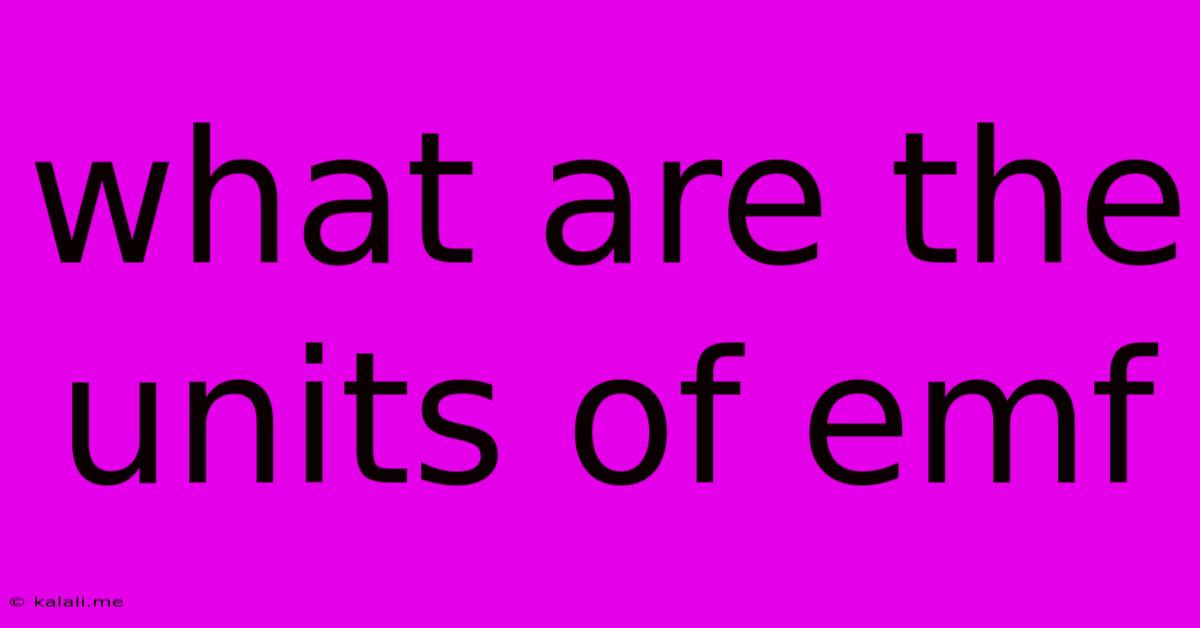What Are The Units Of Emf
Kalali
Jun 14, 2025 · 3 min read

Table of Contents
What are the Units of EMF? Understanding Electromotive Force
Electromotive force (EMF), often mistakenly referred to as a force, is actually the potential difference between two points in an electrical circuit that causes current to flow. It's the energy provided by a source (like a battery or generator) per unit of charge. Understanding its units is crucial for anyone working with electrical circuits and systems. This article will clearly explain the units of EMF and related concepts.
What is EMF? Before diving into the units, let's briefly recap what EMF represents. Think of it as the "push" that drives electrons through a circuit. This push originates from a difference in electrical potential energy, created by chemical reactions (in batteries) or mechanical means (in generators). The greater the EMF, the greater the potential for current flow.
The Standard Unit: The Volt (V)
The standard unit for measuring electromotive force is the volt (V). One volt is defined as the potential difference between two points in a circuit where one coulomb of charge gains one joule of energy.
- 1 Volt (V) = 1 Joule (J) / 1 Coulomb (C)
This means that if a 1-volt EMF source moves 1 coulomb of charge through a circuit, that charge will gain 1 joule of energy. This energy is then dissipated as heat, light, or mechanical work in the circuit components.
Other Related Units and Concepts
While the volt is the primary unit, other related units are important for understanding related concepts:
-
Kilovolt (kV): Used for high-voltage applications, 1 kV = 1000 V. This is common in power transmission lines and some high-voltage equipment.
-
Millivolt (mV): Used for low-voltage applications, 1 mV = 0.001 V. This is often seen in sensor measurements and biological systems.
-
Microvolt (µV): Used for extremely low voltage measurements. 1 µV = 0.000001 V. This is crucial in sensitive instruments and biomedical applications.
-
Ampere (A): Although not a direct unit of EMF, the ampere is crucial for understanding the relationship between EMF, current, and resistance. Amperes measure the rate of charge flow (current) in a circuit, which is directly influenced by the EMF. Ohm's Law (V = IR) connects EMF (V), current (I), and resistance (R).
-
Ohm (Ω): This unit measures electrical resistance. Resistance opposes the flow of current, affecting the relationship between EMF and current in a circuit, as defined by Ohm's Law.
EMF vs. Voltage: Are They the Same?
While the terms EMF and voltage are often used interchangeably, there's a subtle distinction. EMF specifically refers to the source of the potential difference (like the battery's internal chemical reaction), while voltage refers to the potential difference measured across any two points in the circuit. In many practical applications, however, the difference is negligible and they are used synonymously.
Conclusion
The volt (V) is the fundamental unit of electromotive force (EMF). Understanding this unit, along with related units like kilovolts, millivolts, and microvolts, is essential for comprehending electrical circuits and systems. The connection between EMF, current (amperes), and resistance (ohms), as described by Ohm's Law, provides a complete picture of how electricity flows and energy is transferred in various electrical applications. Remember to always use the appropriate unit based on the magnitude of the EMF being measured.
Latest Posts
Latest Posts
-
Different Between Short Run And Long Run
Jun 14, 2025
-
Which Location Is The Flattest Part Of The Ocean
Jun 14, 2025
-
How To Find Minor Of Matrix
Jun 14, 2025
-
What Is The Most Destructive Seismic Wave
Jun 14, 2025
-
How Is Amplitude Related To Energy
Jun 14, 2025
Related Post
Thank you for visiting our website which covers about What Are The Units Of Emf . We hope the information provided has been useful to you. Feel free to contact us if you have any questions or need further assistance. See you next time and don't miss to bookmark.